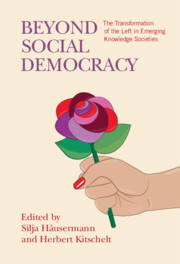Figures
1.1Average vote shares of left parties in national elections in Europe, 1960–2020
1.2Average vote shares of left parties in national elections in Europe, by region, 1960–2020
1.3Causal temporalities in the trajectory of social democratic parties
1.5Ideal-typical programmatic strategies in the political space
1.6Programmatic positions of European parties on the economic and GAL-TAN dimensions
1.7Programmatic positions of European parties on the economic and immigration dimensions
1.8Development of the occupational knowledge economy: service sector employees with tertiary education as a share of total service sector employment
1.9Total expenditures on consumption and investment and weight of spending on investment in total expenditure
1.10Development of electoral shares in national elections for different party families over time, by regions (Continental, Nordic, Southern, and Anglo-Saxon European countries)
1.11Left–right self-positioning and policy preferences on the two dimensions of political competition
3.1Vote shares of social democratic parties in Western Europe
3.2Vote switching from social democratic parties conditional on LR ideology
3.3Vote switching from social democratic parties conditional on education
3.4Vote switching from social democratic parties conditional on union membership
3.6Vote switching from social democratic to other parties, conditional on education
3.7Vote switching between social democratic and other parties
4.1Composition of electorates of party families by respondents and parental class
4.2AMEs of respondents and parental class on support for party families
4.3AMEs of parental class on support for party families, across geographical regions
4.4AMEs of parental class on support for party families, across generations, for Northwestern Europe
4.5Average predicted levels of support for party families by patterns of intergenerational mobility for Northwestern Europe
4.6Average predicted levels of support for party families by patterns of intergenerational mobility among Gen X or Millennial respondents for Northwestern Europe
5.1Transition away from Social Democrats, across entire lifespan
5.6Who switches away from Social Democrats to any other party?
6.1Social democratic electoral potential and mobilization in ten European countries, 2000s and 2010s
6.2Electoral potential and mobilization for different party families in ten European countries, 2000s and 2010s
6.3Inward and outward overlaps by education, Nordic and Continental Europe
6.4Inward and outward overlaps by education, Southern Europe
6.5Inward and outward overlaps as a share of the overall electorate, comparison of magnitudes
6.A1Inward and outward overlaps by subjective class, Continental and Nordic Europe
6.A2Inward and outward overlaps by subjective class, Southern Europe
7.2Attitudinal correlates of vote switching by party family: determinants of switching out and into Social Democracy
7.4Attitudinal correlates of party family switching out of Social Democracy by select education-income groups
8.1Changes in the class composition of trade union membership
8.3Predicted probabilities of policy support on three dimensions
8.4Predicted probabilities of policy support among unionized voters
8.5Standpatters’ and switchers’ policy preference stances on three dimensions
9.1Support for four social democratic programmatic strategies in the entire electorate
9.2Support for four social democratic programmatic strategies among the potential social democratic electorate
9.3Support for four social democratic programmatic strategies by left–right self-positioning
9.4Support for four social democratic programmatic strategies by position on the economic dimension
9.5Support for four social democratic programmatic strategies by position on the cultural dimension
9.6Social Democrats vs. Green Left: predicted probabilities of choosing the social democratic party over the green and left-libertarian option by attitude
9.7Social Democrats vs. Radical Left: predicted probabilities of choosing the social democratic party over the radical left option by attitude
9.8Social Democrats vs. Moderate Right: predicted probabilities of choosing the social democratic party over the moderate right option by sociocultural attitude
9.9Social Democrats vs. Radical Right: predicted probabilities of choosing the social democratic party over the radical right option by attitude
9.10Support for different social democratic programmatic strategies by left–right self-positioning, Austria, Switzerland, and Sweden
9.11Support for different social democratic programmatic strategies by left–right self-positioning, Germany, Spain, and Denmark
10.1Distribution of current vote choices of voters who had chosen major left parties at t − 1
10.2Distribution of movements between prior and current election, all major left parties in the data
10.3Movement from t − 1 to t on the economic left–right scale based on the Comparative Manifesto Project for major left parties
10.4Movement from t − 1 to t on the cultural liberal–conservative scale based on the Comparative Manifesto Project for major left parties
10.5Comparing movements from t – 1 to t, economic left–right and cultural liberal–conservative scales
10.6Moderation in prior cycle and subsequent vote choice of survey respondents who had voted for major left parties in the prior cycle
11.1Parties’ positions relative to mean of the scale and their electoral payoff
11.2Parties’ positions relative to ML (Social Democracy) and ML’s vote share
12.1Predicted vote share of social democratic parties by level of fiscal consolidation and incumbency status
12.2Predicted vote share of social democratic parties by level of spending- and revenue-based consolidations and incumbency status
12.3Predicted vote share of social democratic parties by level of consolidation in different areas and incumbency status
12.A2Distribution of spending- and revenue-based consolidation programs
13.1Leader changes in social democratic and conservative/Christian democratic parties
13.2The polling effects of leadership changes and the frequency of leadership changes
13.4The electoral effects of leadership changes and the frequency of leadership changes
13.5The electoral effects of leadership changes and the frequency of leadership changes conditional on party family

